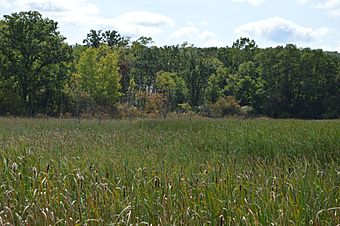Houserville Site facts for kids
Quick facts for kids |
|
|
Houserville Site (36CE65)
|
|

Overview from the north
|
|
| Location | 1300 block of E. College Ave., east of State College |
|---|---|
| Nearest city | College Township, Centre County, Pennsylvania |
| Area | 1.1 acres (0.45 ha) |
| NRHP reference No. | 86000401 |
| Added to NRHP | March 6, 1986 |
The Houserville Site is a very old place near State College, Pennsylvania. It is an archaeological site, which means it's a spot where people find clues about the past. About ten thousand years ago, Native Americans used this site as a workshop for making stone tools. Today, it is protected because it holds important history.
Contents
Where is the Houserville Site Located?
The Houserville Site is found in College Township. It is close to the small community of Houserville. The site sits on top and sides of a small hill, or knoll. This knoll is located above a stream called Slab Cabin Run.
Before European settlers arrived, this area was covered by thick forests. These were mostly hardwood trees. However, since the 1800s, the land has been used for farming. In recent years, more buildings have been constructed nearby. This has led to less farming in the Houserville area.
How Was the Houserville Site Discovered?
In 1978, experts from Pennsylvania State University explored the area. They were doing an archaeological survey. During this survey, they found the Houserville Site. They also found several other important sites along Slab Cabin Run.
One of these nearby sites is the Tudek Site. The Tudek Site was a quarry. This means it was a place where people dug up stone. This stone was then taken to Houserville to be shaped into tools.
What Did Archaeologists Find?
In 1979, archaeologists started digging at the Houserville Site. An anthropologist from Pennsylvania State University led this work. They quickly learned that the site was a workshop for making stone tools. This workshop was used during the Early and Middle Archaic times. This period was between 8000 and 3500 BC.
It is believed that a type of yellow stone, called "Bald Eagle Jasper," was mined at Tudek. This stone was often heated to make it easier to work with. Then, it was carried about 1.5 kilometres (0.93 mi) east to the Houserville Site. There, it was shaped into tools.
What Did We Learn from the Houserville Site?
After the digging was finished, scientists carefully studied what they found. They discovered many interesting objects at the Houserville Site. These included projectile points, which are parts of spears or arrows. They also found stone tools like scrapers and drills. More than seven hundred small pieces of stone, called lithic flakes, were also found. These flakes are bits that break off when stone is shaped.
Scientists believe that groups of people stayed at these sites for short times. Their main goal was to get and work with Bald Eagle Jasper. The Tudek and Houserville sites were used for different things. At Houserville, many tools and flakes were found. But at Tudek, these objects were mostly missing. This suggests that people at Houserville did more than just stonework. They likely also went hunting and prepared animal hides.
Why is the Houserville Site Important?
Archaeologists from Pennsylvania State University say that the Houserville Site is very important. It helps us understand the Archaic period in central Pennsylvania. Tools made from Bald Eagle Jasper have been found in many places. Knowing where this stone came from can help us understand ancient trade routes.
Also, studying these sites helps archaeologists learn why Bald Eagle Jasper was no longer used by later cultures. In early Native American societies, changes in tool-making often came with cultural changes. So, the Houserville Site helps us understand how society developed during the Early and Middle Archaic periods in central Pennsylvania.
Because of its great archaeological value, the Houserville Site was added to the National Register of Historic Places in 1986. The Tudek Site was added four years earlier.



